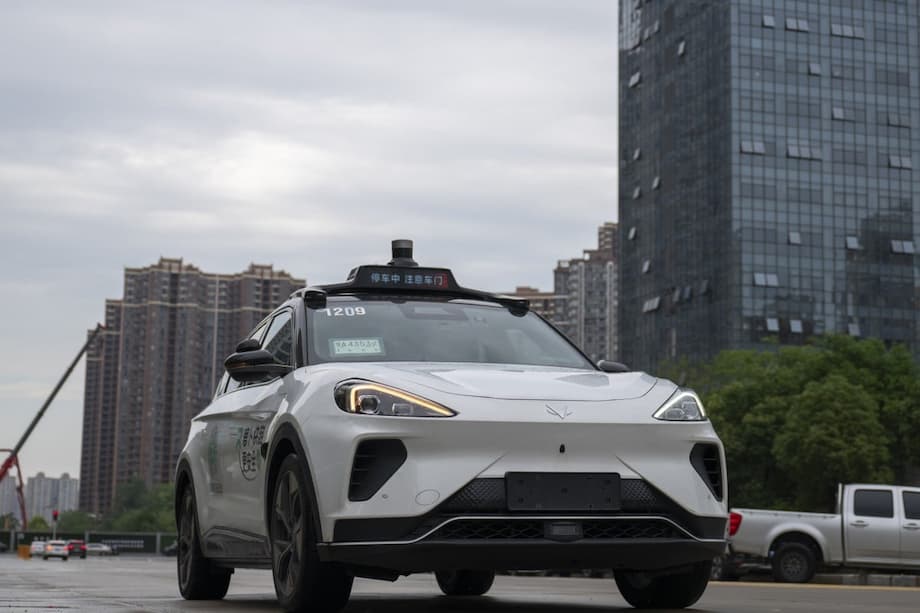China to Deploy 300,000 Driverless Taxis in Major Cities by 2030, Accelerating Global Robotaxi Race
UBS and industry analysts forecast explosive growth as China leads the world in autonomous taxi adoption, reshaping urban mobility and the ride-hailing market.
China is set to deploy 300,000 driverless taxis in its four largest cities by 2030, according to forecasts from UBS and other industry analysts. This ambitious rollout, driven by rapid advances in artificial intelligence and the country’s thriving electric vehicle sector, positions China at the forefront of the global robotaxi revolution. The move is expected to transform urban transportation, address labor shortages, and create a multi-billion-dollar market for autonomous mobility services.
- China to Deploy 300,000 Driverless Taxis in Major Cities by 2030, Accelerating Global Robotaxi Race
- Why Is China Betting Big on Robotaxis?
- How Big Is the Robotaxi Market in China?
- What Makes Robotaxis Attractive for Cities and Consumers?
- How Does China Compare to the Rest of the World?
- What Technologies Power the Robotaxi Revolution?
- Investment Opportunities and Industry Outlook
- Key Points
The plan targets China’s top-tier cities—Beijing, Shanghai, Guangzhou, and Shenzhen—where demand for ride-hailing is high and urban populations are dense. The deployment is part of a broader national strategy to integrate autonomous vehicles into daily life, supported by government policies, regulatory frameworks, and significant investment from both established automakers and technology startups.
Why Is China Betting Big on Robotaxis?
China’s push for driverless taxis is fueled by several converging factors. The country faces rising labor costs, especially for taxi and ride-hailing drivers, and a growing need for efficient, scalable urban transportation. At the same time, Chinese consumers are increasingly open to new technologies, and the government has made autonomous vehicles a priority in its smart city and innovation agendas.
Paul Gong, head of China automotive research at UBS, explained the productivity benefits of autonomous vehicles in a recent report:
“Given the fast development of technologies and the increasingly expensive labour cost, autonomous vehicles will be highly helpful in driving productivity.”
Gong and other analysts believe that the lower cost of building electric vehicles equipped with autonomous systems is a key driver for the expansion of robotaxi fleets. The production cost of a self-driving taxi in China is expected to fall below 300,000 yuan (about $41,935), making large-scale deployment financially viable for operators.
China’s regulatory environment is also a major enabler. Authorities are actively working on standards, pilot programs, and infrastructure upgrades to support autonomous vehicle testing and commercialization. Cities like Wuhan have already seen Baidu’s Apollo Go operate over 400 driverless vehicles, serving as a model for future urban deployments.
How Big Is the Robotaxi Market in China?
Estimates for the size and growth of China’s robotaxi market vary, but all point to massive potential. UBS projects that if all two million traditional taxis and five million ride-hailing cars in China are eventually replaced by autonomous vehicles, the market could reach $183 billion annually by the late 2030s. Even in the near term, HSBC estimates robotaxis could make up 6% of the country’s taxi market, with an initial market size topping $40 billion a year.
Other financial institutions offer even more aggressive forecasts. Goldman Sachs predicts up to 500,000 robotaxis could be operating in more than 10 Chinese cities by 2030, while Barclays and MarketsandMarkets see the market surging to $45.7 billion by the same year. By 2035, China’s robotaxi fleet could approach two million vehicles, according to Goldman Sachs insights.
Beyond passenger transport, autonomous taxis are expected to generate significant revenue from logistics and delivery services. HSBC estimates this segment alone could be worth $30 billion annually, as e-commerce and last-mile delivery needs continue to grow.
Key Players and Competitive Landscape
China’s robotaxi sector is fiercely competitive, with major technology companies, automakers, and startups vying for market share. Leading the charge are:
- Baidu: Its Apollo Go service is already running hundreds of driverless vehicles in cities like Wuhan and has received approval for testing in Hong Kong.
- Pony AI: Backed by strong technical capabilities and a “Virtual Driver” platform, Pony AI has begun commercial, fee-charging operations in tier-1 cities and is seen as a top contender by UBS analysts.
- Didi Chuxing: Leveraging its massive ride-hailing user base, Didi is investing heavily in autonomous vehicle R&D and pilot programs.
- Apollo (Baidu’s autonomous division): Alongside Pony AI, Apollo is recommended by UBS as well-positioned to capture growth in the sector.
International players are also eyeing the Chinese market. Tesla has announced plans to launch robotaxi fleets in China, though regulatory approval for its Full Self-Driving features is still pending. Partnerships like WeRide’s collaboration with Uber in the UAE highlight the global ambitions of Chinese robotaxi firms.
What Makes Robotaxis Attractive for Cities and Consumers?
Robotaxis promise to reshape urban mobility by offering cheaper, safer, and more accessible transportation. Key advantages include:
- Lower operating costs: By eliminating driver salaries and enabling 24/7 operation, robotaxis can reduce the cost per mile to as low as $0.25–$0.50, making rides 40–60% cheaper than traditional taxis.
- Improved safety: Autonomous vehicles are designed to reduce human error, which is responsible for the majority of traffic accidents. Studies from companies like Waymo show far fewer injury-causing crashes compared to human drivers.
- Environmental benefits: Most robotaxis are battery-electric, supporting China’s goals for lower emissions and cleaner urban air.
- Increased accessibility: Robotaxis can serve areas and times where human-driven taxis are scarce, improving mobility for elderly, disabled, or underserved populations.
Public acceptance is rising, with surveys indicating that up to 65% of urban dwellers in China are willing to use robotaxis by 2030. Integration with ride-sharing apps, real-time booking, and digital payments make the service convenient and familiar to users already accustomed to platforms like Didi and Meituan.
Challenges: Regulation, Safety, and Public Trust
Despite the optimism, several challenges remain before robotaxis become a daily reality for millions. Regulatory approval is a complex process, requiring rigorous safety testing, data sharing, and the development of new insurance models. Chinese authorities are establishing monitoring bodies and pilot zones to build public confidence and ensure safe deployment.
Safety incidents involving autonomous vehicles, both in China and abroad, have raised concerns about reliability and accountability. Companies must demonstrate that their vehicles can handle complex urban environments, unpredictable human behavior, and adverse weather conditions. Public trust will be critical, and any high-profile accidents could slow adoption.
How Does China Compare to the Rest of the World?
China is not alone in the race to deploy robotaxis, but it is moving faster than most other countries. The United States, led by companies like Waymo and Cruise, has launched commercial autonomous rides in select cities but faces a patchwork of state regulations and ongoing safety reviews. By 2030, the U.S. is expected to have about 35,000 robotaxis on the road, far fewer than China’s projected hundreds of thousands.
Europe is advancing with strong urban mobility programs and emission targets, but widespread robotaxi deployment is still in early stages. South Korea, Germany, and Japan are preparing for launches by 2025, focusing on pilot programs and smart city integration.
Globally, the robotaxi market is forecast to reach $40–$45 billion by 2030, with China, the U.S., and Europe accounting for 80% of the total. By 2030, an estimated 2.5 million robotaxis could be operating worldwide, with China aiming for 1 million and the U.S. for over 500,000. Adoption is expected in more than 200 cities, requiring significant upgrades to infrastructure and urban planning.
Economic and Social Impact
The rise of robotaxis is expected to disrupt the traditional taxi and ride-hailing industries, reduce personal car ownership, and reshape city landscapes. Economic models suggest that robotaxis could replace 30–50% of human-driven ride-hailing trips, reduce traffic accidents by up to 80%, and lower insurance costs by 50–70%. Fleet utilization rates could exceed 70%, compared to 40% for traditional taxis, making the business model more efficient and profitable.
Integration with public transport and shared mobility services could reduce the number of vehicles on the road by 30%, easing congestion and cutting CO2 emissions by 40%. The shift toward Mobility-as-a-Service (MaaS) is already changing how people think about transportation, with on-demand, flexible options replacing private car ownership in many urban areas.
What Technologies Power the Robotaxi Revolution?
Robotaxis rely on a combination of advanced technologies to navigate city streets safely and efficiently. Key components include:
- Artificial Intelligence (AI) and Machine Learning: These systems process vast amounts of data from sensors, cameras, and maps to make real-time driving decisions.
- LiDAR and Radar Sensors: LiDAR (Light Detection and Ranging) creates detailed 3D maps of the environment, while radar detects objects and measures their speed, even in poor visibility.
- V2X Communication: Vehicle-to-everything (V2X) technology allows robotaxis to communicate with traffic lights, other vehicles, and infrastructure for safer, more coordinated driving.
- Electric Propulsion: Most robotaxis are battery-electric, benefiting from lower operating costs, reduced emissions, and government incentives.
Continuous innovation in AI, sensor fusion, and battery technology is driving down costs and improving performance. Companies are also investing in cybersecurity, data privacy, and remote operation systems to address new risks associated with autonomous vehicles.
Investment Opportunities and Industry Outlook
The robotaxi boom is attracting significant investment from automakers, tech giants, venture capitalists, and public markets. UBS analyst Paul Gong recommends stocks like Pony AI and Apollo as best positioned to capture growth in China’s $183 billion market. Both companies have demonstrated strong technical capabilities and are expanding commercial operations in major cities.
Industry insiders see opportunities not only in vehicle manufacturing but also in ancillary technologies such as sensors, software, mapping, and fleet management. As robotaxi networks scale, suppliers of LiDAR, AI chips, and cloud computing services are expected to benefit.
However, investors should be aware of risks, including regulatory changes, technological hurdles, and public acceptance. The path to profitability depends on achieving high fleet utilization, reducing costs, and navigating a competitive landscape with both domestic and international players.
Key Points
- China aims to deploy 300,000 driverless taxis in its four largest cities by 2030, leading the global robotaxi race.
- Market forecasts predict up to 500,000 robotaxis in China by 2030 and nearly 2 million by 2035, with the sector potentially worth $183 billion annually by the late 2030s.
- Major players include Baidu, Pony AI, Didi Chuxing, and Apollo, with international companies like Tesla seeking entry.
- Robotaxis promise lower costs, improved safety, and environmental benefits, but face challenges in regulation, safety, and public trust.
- China’s supportive regulatory environment and consumer openness are accelerating adoption compared to the U.S. and Europe.
- Technological advances in AI, sensors, and electric vehicles are making large-scale deployment feasible and cost-effective.
- The rise of robotaxis is expected to disrupt traditional taxi and ride-hailing industries, reduce car ownership, and reshape urban mobility worldwide.












